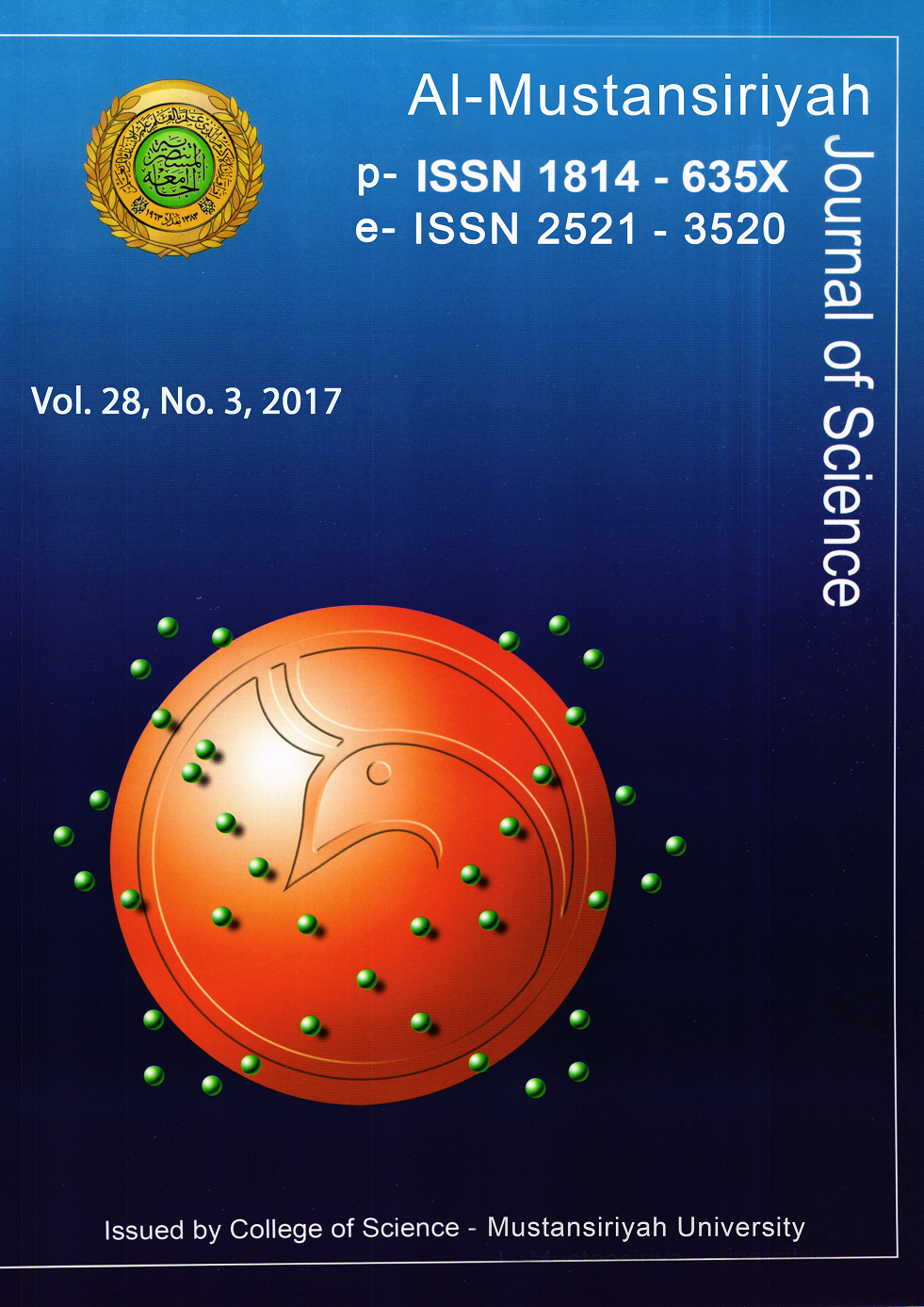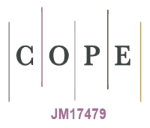Production and Partial Purification of Tannase from Serratia Marcescens Isolated from Different Sources
DOI:
https://doi.org/10.23851/mjs.v28i3.550Keywords:
Serratia marcescens, tannase, partial purification, optimum conditions.Abstract
Tannase has different benefits in food, chemical and pharmaceutical fields. Seventeen Serratia marcescens isolates were collected from septicemia, wound infections and hospital environment(babies incubators).These isolates were identified by biochemical tests and Vitek 2 system that contained Vitek GNI card then conformed by16S rRNA gene products(amplified size 179 bp) for genotypic detection. After that, they screened for higher tannase production and Serratia marcescens b9 was a better producer of tannase with a larger diameter of a dark green zone. The tannase activity was increased to 63U/ml when this isolate was cultivated under the optimal conditions which consisted of using nutrient broth supplemented with ber leaves at pH value 5.5 and a temperature equals to 37°C for 72 hours. In the partial purification of tannase, ammonium sulfate was more efficient than organic solvents, since it was found that 70% saturation of ammonium sulfate led to precipitate of tannase with tannase activity of 80U/ml. In contrast, 30% of ethanol, acetone, and isopropanol led to precipitate of tannase with different levels of activity ranged between 45-47U/ml. Consequently, ber leaves have a potential as an effective and much cheaper (economical) substrate for tannase production in comparison with traditionally used substrates like tannic acid.Downloads
References
Arslan, U.; Erayman, I.; Kirdar, S.; Yuksekkaya, S.; Cimen, O.; Tuncer, I. and Bozdogan, B.(2010). Serratia marcescens sepsis outbreak in a neonatal intensive care unit. Pediatr. Int., 52:208-212.
Hejazi, A. and Falkiner, F.R.(1997). Serratia marcescens. Medical Microbiology,46:903-912.
Hejazi, A.; Aucken, H. M. and Falkiner. F. R.(2000). Epidemiology and susceptibility of Serratia marcescens in a large general hospital over an 8-year period. J. Hosp. Infect.,45:42-46.
Soni, M.; Sharma, K.P.; Kaushik, S. and John, P.J.(2012). Purification and characterization of gallic acid decarboxylase from Enterobacter spp. isolated from a region in Rajasthan, India. International Journal of Biosciences,2(12):97-104.
Shanmugapriya, N.; Ramganesh, S. and Labhane, N.(2014). Production, Purification And Characterization Of Tannase From Native Aspergillus sp. Using Syzygium Cumini (L) Skeels (Eugenia Jambolana) Seed Powder. Golden Research Thoughts.3(9):1-12.
Jana, A.; Halder, S.K.; Banerjee, A.; Paul, T.; Pati, B.R.; Mondal, K.C. and Mohapatra, P.K.(2014). Biosynthesis, structural architecture and biotechnological potential of bacterial tannase: A molecular advancement. Bioresour. Technol.,24:80-86.
Pepi, M.; Lampariello, L.; Altieri, R.; Esposito, A.; Perra, G.; Renzi, M.; Lobianco, A.; Feola, A.; Gasperini, S.; Focardi, S.E.(2010). Tannic acid degradation by bacterial strains Serratia spp. and Pantoea sp. isolated from olive mill waste mixtures. International Biodeterioration & Biodegradation, 64:73-80.
Enemuor, S.C. and Odibo, F.J.(2010). Partial purification and characterization of Aspergillus tamari IMI388810 (B) tannin acyl hydrolase. Arch. Appl. Sci. Res.,2(6):290-299.
Inamdar, A.(2014). Production of Taninolytic Enzyme Under different Fermentation Process with reference to substrate consumption profile. Int.J.Curr.Microbiol.App.Sci,3(6):583-590.
Brenner, D.J.; Krieg, N.R.; Staley, J.T.; Garrity, G.M.; Boone, D.R.; De Vos, P.; Goodefellow, M.; Rainey, F.A. and Schleifer, K.H. (2005). Bergey’s. Manual of Systematic Bacteriology, 2nd Edition, Michigan State University, Springer, East Lansing.
Ruppé, E.; Hem, S.; Lath, S.; Gautier,V.; Ariey, F.; Sarthou, J.L.; Monchy, D. and Arlet, G. (2009). CTX-M β- Lactamases in Escherichia coli from Community acquired Urinary Tract Infections, Cambodia. Emerge Infect Dis,15(5):741-8.
Sambrook, J. and Russell, D.W.(2001). Molecular Cloning: A Laboratory Manual Cold Spring Harbor. New York, USA, ColdSpring Harbor Laboratory Press.
Iwaya, A.; Nakagawa, S.; Iwakura , N.; Taneike, I.; Kurihara, M.; Kuwano, T.; Gondaira, F.; Endo, M.; Hatakeyama, K. and Yamamoto, T.(2005). Rapid and quantitative detection of blood Serratia marcescens by a real-time PCR assay: Its clinical application and evaluation in a mouse infection model. FEMS Microbiology Letters,248:163-170.
Kumar, R.; Kumar ,A.; Nagpal, R.; Sharma J. and Kumari, A.(2010). A novel and sensitive plate assay for screening of tannase-producing bacteria. Ann. Microbiol.,60:177-179.
Miller, G.(1959). Use of Dinitrosalicyclic acid reagent for Determination of reducing sugar, Anal. Chem., 31:426.
Bradford, M.(1976). A rapid and sensitive method for the quantitation of microgram quantitities of protein utilizing the principle of protein dye binding, Annal . Biochem. ,72:248-254.
Brahmbhatt, D. and Modi, H.A.(2015). Comparative Studies on Methods of Tannase Assay. International Journal for Research in Applied Science & EngineeringTechnology, 3(3):715-720.
Mostatabi, N.; Farshad, S. and Ranjbar, R.(2013). Molecular evaluations of extended spectrum β-lactamase producing strains of Serratia isolated from blood samples of the patients in Namazi Hospital, Shiraz, Southern Iran. Iran. J. Microbiol.,5(4):328-333.
Khanna, A.; Khanna, M. and Aggarwal, A.(2013). Serratia Marcescens- A Rare Opportunis¬tic Nosocomial Pathogen and Measures to Limit its Spread in Hospitalized Patients. Journal of Clinical and Diagnostic Research.,7(2):243-246.
Lai, K.K.; Baker, S.P. and Fontecchio, S.A.(2004). Rapid eradication of a cluster of Serratia marcescens in a neonatal intensive care unit: use of epidemiologic chromosome profiling by pulsed-field gel electrophoresis. Infect. Control Hosp. Epidemiol.,25(9):730-734.
Ibrahim, I. A. and Hameed, T. A.(2015). Isolation, Characterization and Antimicrobial Resistance Patterns of Lactose-Fermenter Enterobacteriaceae Isolates from Clinical and Environmental Samples. Open Journal of Medical Microbiology,5:169-176.
Byrne, A.H.; Herra, C.M. ; Aucken, H. and Keane, C.T.(2001). Rate of carriage of Serratia marcescens in patients with and without evidence of infection. Scand. J. Infect. Dis.,33(11):822-826.
Nandini, S.; Ke, N. and Sundari ,S.K.(2015). Food and Agriculture Residue (FAR): A Potential Substrate for Tannase and Gallic Acid Production using Competent Microbes. J. Bioproces. Biotech.,5(1):1-8.
Brahmbhatt, D.; Modi, H.A. and Jain, N.K.(2014). Preliminary isolation and screening of tannase producing bacteria and fungi. Int.J.Curr.Microbiol.App.Sci.,3(11):193-203.
Nandini, K.E.; Gaur, A,. and Sundari, S.K.(2013). The suitability of natural tannins from food and agricultural residues (FAR) for producing industrially important Tannase and Gallic acid through microbial fermentation. Int. J. Agric. Food Sci. Technol., 4:999-1010.
Raghuwanshi,S.; Dutt,K.; Gupta, P.; Misra, S. and Saxena, R.K.(2011). Bacillus sphaericus: the highest bacterial tannase producer with potential for gallic acid synthesis.J. Biosci. Bioeng.,111(6):635-640
Molkabadi, E.Z.; Esfahani, Z.H.; Sahari, M.A. and Azizi, M.H.(2015). Statistical Optimization of Tannase Production by Penicillium sp. EZ-ZH390 in Submerged Fermentation. Appl. Food Biotechnol.,2(3):63-70.
Riul, A.J.; Goncalves, H.B.; Jorge, J.A. and Guimaraes, L.H.S.(2013). Characterization of a glucose- and solvent-tolerant extracellular tannase from Aspergillus phoenicis. J. Mol. Catal. B: Enzym., 85:126-133.
Ahmed, M.E. and Abdal Rhman, H.J.(2014). Detection of the perfect condition to produce the tannase from Aspergillus niger at different medium. Pure and Applied Sciences, 22(3):1363-1371.
Belur, P.D.; Mugeraya, G.; Nirmala, K.R. and Basavaraj, N.(2010). Production of novel cell-associated tannase from newly isolated Serratia ficaria DTC. J. Microbiol. Biotechnol.,20: 732-736.
Deschamps, A.M.; Otuk, G. and Lebeault, J.M. (1983). Production of tannase and degradation of chestnut tannin by bacteria. J. Ferment. Technol., 61:55-59.
Muslim, S.N; Mahammed, A.N; Musafer, H.K.; Al- kadmy, I.M.S; Shafiq, S.A (2015). Detection of the Optimal Conditions for Tannase Productivity and Activity by Erwinia carotovora Isolated from Spoilt Vegetables Infected with Soft Rotting Disease., J. Medical and Bioengineering,4(3):198-205.
Das Mohapatra, P.K.; Mondal, K.C. and Pati, B.R.( 2006). Production of tannase through submerged fermentation of tannin-containing plant extracts by Bacillus licheniformis KBR6. Pol. J. Microbiol.,55:297-301.
Selwal, M.K.; Yadav, A.; Selwal, K.K.; Aggarwal, N.K.; Gupta, R. and Gautam, S.K.(2010). Optimization of cultural conditions for tannase production by Pseudomonas aeruginosa IIIB 8914 under submerged fermentation. World J. Microbiol. Biotechnol.,26:599-605.
Kuppusamy, M.; Thangavelu,V. and Chokalingam,A.(2012). Optimization of Submerged Fermentative Production of Tannase by Aspergillus flavus. Int. J. Chem.Tech. Res.4(4):22-27.
Jana, A.; Maity, C.; Halder, S.K.; Das, A.; Pati, B.R.,; Mondal, K.C.and Das Mohapatra, P.K.(2013). Structural characterization of thermostable, solvent tolerant, cytosafe tannase from Bacillus subtilis PAB2. Biochem. Eng. J.,77:161-170.
Muslim, S.N; Mahammed, A.N and Al- kadmy, I.M.S (2015). Detoxification of zearalenone produced by Fusarium graminearum by purified tannase from Citrobacter freundii. Greener Journal of Biochemistry and Biotechnology.2(1):001-008.
SabuA.; Augur, C.; Swati,C.; Pandey,A.(2006). Tannase production by Lactobacillus sp. ASR-S1 under solid-state fermentation, Process Biochem., 41:575-580.
Sheela, S.; Smita, V. and Dipak, V.(2016).Optimization of parameters for enhanced tannase production from a novel bacterial producer. World Journal of Pharmaceutical Research, 5(6):2131-2139.
Sivashanmugam. A and Jayaraman,G.(2011). Production and partial purification of extracellular tannase by Klebsiella pneumonia MTCC 7162 isolated from tannery effluent, Afr. J. Microbiol. Res., 10:1364-1374.
Jana, A.; Maity, C.; Halder, S.K.; Pati, B.R.; Mondal, K.C. and Das Mohapatra, P.K.(2013). Enhanced tannase production by Bacillus subtilis PAB2 with concomitant antioxidant production. Biocatal. Agric. Biotechnol., 2:363-371.
Wilson, P.; Rojan,A.; John, P.; Kumar, P. and Thomas, S. (2009). Tannin acyl hydrolase Production by Citrobacter species isolated from Tannin rich Environment, using Tamarindus indica seed powder. Journal of Applied Sciences and Environmental Management., J. Appl. Sci. Environ. Manage., 13(4),:95-97.
Mondal, K.C.; Banerjee, D.; Banerjee, R. and Pati, B.R.(2001). Production and characterization of tannase from Bacillus cereus KBR9. J. Gen. Appl. Microbiol., 47:263–267.
Beena, P. S.; Soorej, M.B.; Elyas, K.K .; Sarita, G.B. and Chandrasekaran, M.(2010). Acidophilic Tannase from Marine Aspergillus awamori BTMFW032. J. Microbiol. Biotechnol., 20(10):1403-1414.
Battestin, V. and Macedo, G.A.(2007). Effects of temperature, pH and additives on the activity of tannase produced by Paecilomyces variotii. Electronic Journal of Biotechnology,10 (2):35-38.
Yao, J.; Guo, G.S.; Ren, G.H. and Liu, Y.H.(2014). Production, characterization and applications of tannase. Journal of Molecular Catalysis B: Enzymatic, 101:137-147.
Downloads
Key Dates
Published
Issue
Section
License
(Starting May 5, 2024) Authors retain copyright and grant the journal right of first publication with the work simultaneously licensed under a Creative Commons Attribution (CC-BY) 4.0 License that allows others to share the work with an acknowledgement of the work’s authorship and initial publication in this journal.






















